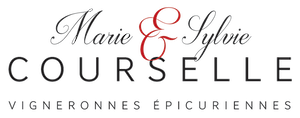If there were ever a magic place in all the world, it would have to be Clos Sainte Anne! Originally a Priory and later, a vineyard, this magical spot is reminiscent of Tuscany – all small valleys, gentle contours and refined light. This pleasant and yes, somewhat magical enclave is tucked away from the tumult of the outside world and it is where Marie Courselle chose to settle with her family. The wine produced here reflects the special environment. In these south-facing terraces above the Garonne, Merlot vines enjoy very accommodating conditions. They pay homage to their peaceful surroundings with wines of great quality and superb elegance.
Be tempted to discover the soul of this terroir via its wine which will completely bewitch you, just as it has every member of the Courselle family.
Marie & Sylvie Courselle
Clos Sainte Anne - Cadillac Côtes de Bordeaux
GRAPE : 90 % Merlot, 10 % Cabernet Franc
SOIL : Gravel over Clay. The hillsides form a terraced, south-facing vineyard overlooking the Garonne. The gravel on the surface helps creates a special microclimate.
MATURATION : 60 % of the blend is aged in barrels (of which 20% are new) and the balance in tank. Two rackings are carried out during the 12 months of maturation.
TASTE : This wine shows its elegance from start to finish – in a bouquet of ripe fruits, violets and toast; a generous and sweet mouthfeel, and with its refined tannins and spicy finish.
FOOD PAIRINGS : Lamb cutlets, duck with cherries (to echo the red fruits of the wine), or a rib of beef (Bazas, nearby-by is famous for it) are some of the ways to enjoy this feminine red. Soft cheeses (Brie, Brillat, Camembert) are a more traditional pairing. Spicy chocolate mousse or fondant with Espelette chillies gives you an excuse to finish the bottle.


Clos Sainte Anne - Cadillac Liquoreux (dessert wine)
GRAPES : 60% Sémillon 40% Sauvignon Gris
HARVEST : Grapes are either partially raisined (allowed to dry out naturally on the vine) or botrytised (affected by Noble Rot as in Sauternes) then harvested by hand.
WINEMAKING : The alcoholic fermentation takes place in oak barrels, then the sweet wine (whose fermentation is not yet complete) stays in barrel for between 6 to 9 months. The wine is bottled early to avoid having to use high doses of SO2.
TASTE : The wine’s aromas remind us of our grandmother’s cuisine: quince jelly, rhubarb, lychees, with notes of verbena. What makes this easy-drinking wine extra special is the balance, with the emphasis on freshness rather than on sweetness.
